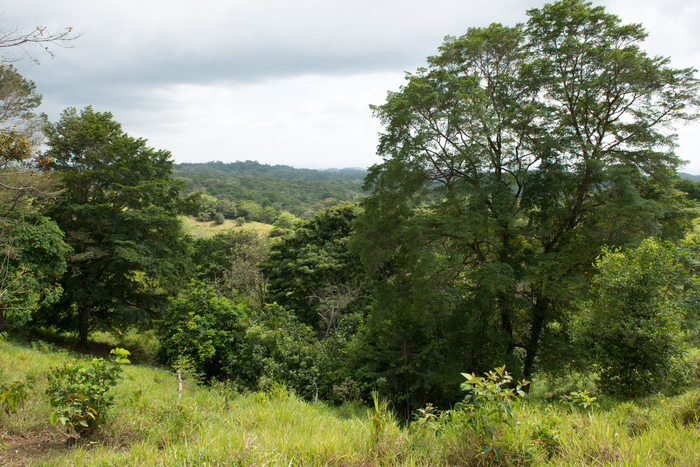According to a recent study by Smithsonian Tropical Research Institute (STRI) postdoctoral fellow Karina Chavarria and colleagues, bacterial communities in streams neighboring young secondary forests recover to look like those of mature forest streams in as little as 10 years after cattle has been moved away from the land, and these communities are resilient during the course of the year.
 Over a two-year period, Chavarria and colleagues took weekly samples from streams surrounded by mature forest, young secondary forest, silvo- and traditional pasture at STRI’s Agua Salud site to analyze the bacterial content of the water. (Image Credit: Jorge Aleman, Smithsonian Tropical Research Institute).
Over a two-year period, Chavarria and colleagues took weekly samples from streams surrounded by mature forest, young secondary forest, silvo- and traditional pasture at STRI’s Agua Salud site to analyze the bacterial content of the water. (Image Credit: Jorge Aleman, Smithsonian Tropical Research Institute).
The study has been published in Scientific Reports. These results have been reported at a critical time, as 2021 denotes the beginning of the United Nations Decade on Ecosystem Restoration, which aims to avert, halt and reverse the ruin of ecosystems globally.
The Agua Salud Project, a partnership with the Panama Canal Authority and the Ministry of the Environment in Panama, and where this study was carried out, is one of the many initiatives at STRI intended to understand the triggers and significances of environmental change.
Lessons gained from years of research on forest ecosystems across various land uses and extreme weather events at Agua Salud provide information on mankind’s ability to restore and preserve tropical forests. With its numerous streams and rivers spread across hundreds of hectares, Agua Salud also provides a unique platform for hydrological research explorations.
Water is the main resource to sustain life. People depend on lakes and streams for food and recreation. Microbes are the less valued constituents of water systems but are the underlying engineers that safeguard water quality by cycling energy and nutrients.
When streams are polluted or adjacent landscapes are degraded, microbial communities move, risking their ability to help preserve natural processes and frequently letting destructive bacteria thrive.
Chavarria and colleagues gathered weekly samples from streams bordered by silvo- and traditional pasture, mature forest and young secondary forest over a two-year period at STRI’s Agua Salud site. They figured various features of water quality, and filtered water samples to obtain and sequence the bacterial DNA in these streams.
They discovered similar communities in streams bordered by young secondary and mature forests but different, less varied communities in the cattle pasture stream. Particularly, the bacterial community in the silvopasture stream moved seasonally, with the wet season bacterial community akin to the forests and the dry season community akin to the traditional pasture.
Riparian forest helps to protect the silvopasture stream from the impacts of cattle in the wet season but in the dry season, when cows congregate in the stream to drink and seek shade as a way of avoiding the scorching sun, increased disturbance and fecal inputs make the bacterial community in the water more like that of traditional cattle pastures.
Kristin Saltonstall, Staff Scientist and Project Collaborator, STRI
Kristin Saltonstall is also Chavarria’s advisor.
It is important that cattle not access the streams, and that their drinking water is provided up slope during the dry season to ensure year-round water quality.
Jefferson Hall, Project Collaborator and Director of Agua Salud, STRI
Silvopasture systems, where trees are grown on forest corridors and traditional cattle pastures are usually maintained along streams, have garnered more attention in the last few years.
While the verdict is yet to be made as to whether these systems offer all the environmental advantages mentioned by promoters, it is evident that having a forest buffer enclosing the stream is favorable with respect to stream water bacterial communities and water quality.
Our results add an important dimension to the growing body of research on the ability of biodiversity associated with young tropical secondary forests to recover rapidly, with implications for human health as well as a healthy environment.
Karina Chavarria, Postdoctoral Fellow, STRI
Mitigation work performed during this Decade of Ecosystem Restoration will establish the quality of life on earth for future generations. Chavarria’s study offers hope, demonstrating that passive reforestation, where forests are permitted to recover after cattle are moved away, can restore many facets of water quality within a few years.
Studies such as this deliver the much-desired data and show how science can impact policy and practice, helping to sustain the earth.
Journal Reference:
Chavarria, K.A., et al. (2021) Land use influences stream bacterial communities in lowland tropical watersheds. Scientific Reports. doi.org/.10.1038/s41598-021-01193-7.